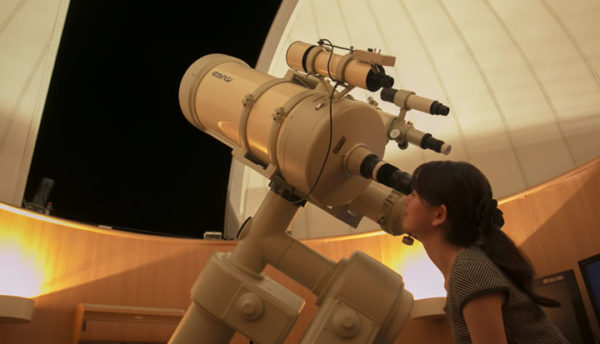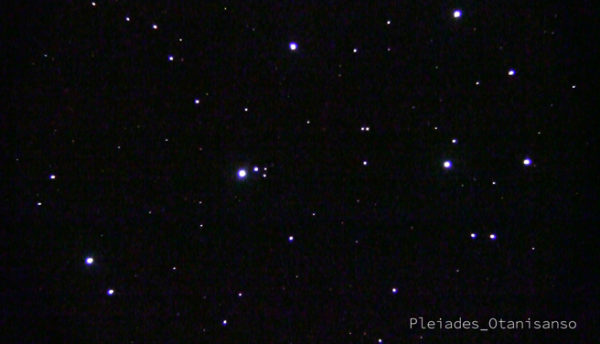- Astronomical Observatory
- 2019/04/17
【March in the Observatory】Moonlit nights and the brilliant, wintry shimmer of the stars…come observe the winter skies!
This is the last month that you’ll be able to see winter constellations like Sirius and the Pleiades.
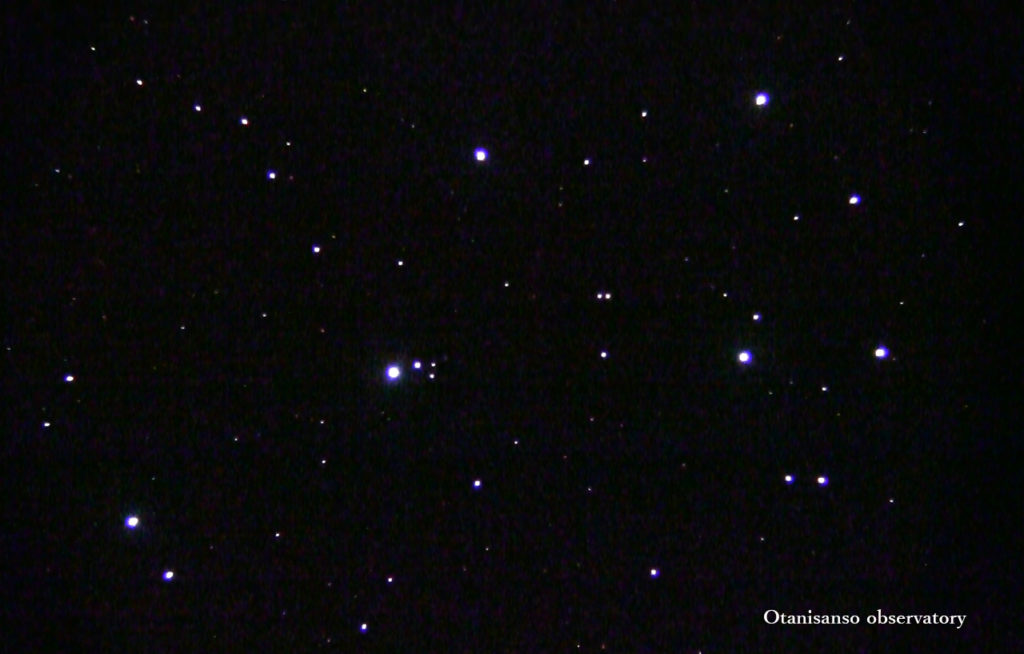
Shimmering like a white diamond, the Pleiades are even mentioned in the 9th century Japanese classic, “The Pillow Book.”
Greetings from the Otani Sanso Astronomical Observatory Dome.
oday we’ll be discussing Nagato’s night skies in March, 2019. During March, the seasons begin to shift from winter into spring, even in the astronomical world. To begin with, the star Sirius. You’ll see this fixed star shimmering conspicuously when you look up at the southeastern sky. Sirius is one of the stars making up winter’s great triangle (Betelgeuse, Sirius, and Procyon), and it is located at a distance of 8.6 light years from earth, making it relatively close to earth. Because of this, Sirius does not have the greatest instrinsic brightness of the stars, but as the brightest of the fixed stars in the sky, it has an apparent magnitude of -1.5. Next up is the Pleiades constellation (one of the most well-known open clusters). In Japan, it is known as “Subaru,” and in other countries it is also known as the “Seven Sisters.” Clustered at the shoulder of the constellation of Taurus, it is located at a distance of 408 light years. The brightest 6-7 stars within this constellation are visible to the naked eye, but if you observe the constellation through a telescope, you’ll be able to see a formation of over a hundred stars. The spectacle of these stars looks something like a shimmering white diamond. In fact, these stars, which were born some 60 million years ago, are relatively young stars, but“Because of their intense combustion, the lives of these stars will be short, and it’s said that in another 10 million years or so, they will probably explode into supernovas and die.” (Source: Space Information Center Official Website)
The Pleiades were selected as a favorite star of the author Sei Shonagon in her complete 9th century “Pillow Book.” When you come to visit the astronomical observatory dome, come see if you can count, “How many stars can you see?” Towards the end of March, the spring constellations will begin to appear. Many of these are constellations that are familiar, or those you may have heard of, including the Big Dipper, Leo, the star Arcturus in the constellation of Boötes, the herdsman. When these celestial bodies come into view, we’ll help you to find them. (Image was photographed at the Otani Sanso Astronomical Observatory Dome: Above, the Pleiades; below, Arcturus)
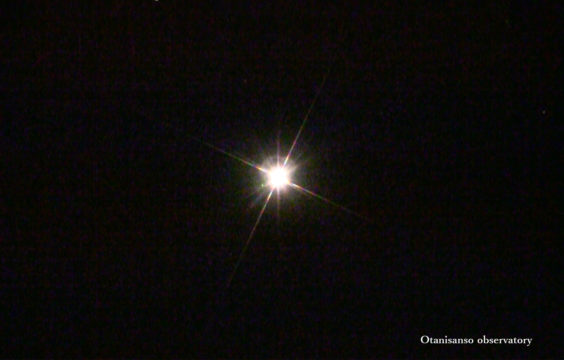
Stars & Greek Myth: About the Pleiades Star Cluster (the “Seven Sisters”)
The beautiful shimmer of the Pleiades star cluster has given birth to many myths since long ago, including this one: the Pleiades were the seven daughters of the giant Atlas and the sea nymph Pleione (their names being Maia, Electra, Taygete, Alcyone, Celaeno, Sterope, and Merope). Living together in the forest assisting the moon goddess Artemis, the seven sisters were also pursued by Orion. Artemis turned the sisters into doves and released them into the sky, after which they turned into stars. The constellation of Orion can be seen nearby the Pleiades star cluster, almost as if he were chasing them. Use this as a hint when you try to find the Pleiades in the sky.
Stellar Objections Expected to be Visible in March
- Until March, 22 (Fri): the Pleiades, Sirius プレアデス星団(すばる)、シリウス
- March 23 (Sat) – 31 (Sun): the Pleiades or Sirius プレアデス星団(すばる)又はシリウス
- *Around the end of March, we will begin to be able to see the spring constellations (the Big Dipper, Leo, and the star Arcturus in the constellation Boötis).
<Making a Reservation at the Astronomical Observatory>
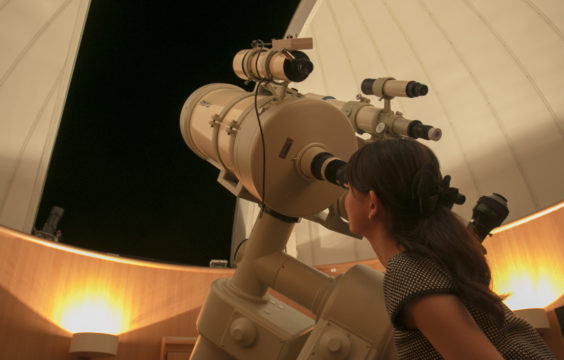
Details
- Observatory Hours… 7:30 p.m. – 10:10 p.m.
- Closed on… Every Tuesday
- Location… Otani Sanso Roof (Just beside the gallery on the 8th floor)
- Price… Free for overnight guests (Viewings available to those who reserve first)
- Using the Observatory… Viewings are available to those who reserve first (12 seats per viewing)
Observation Times
- 7:30 p.m., 7:50 p.m.
- 8:10 p.m., 8:30 p.m., 8:50 p.m.
- 9:10 p.m., 9:30 p.m., 9:50 p.m.
How to Make a Reservation
Please inform us of your desired reservation time from the times listed above (Please tell us via telephone, or write it in the “requests” field) *You may not be able to participate in a viewing if a time slot is fully booked, or due to weather conditions. *Should you be unable to participate in a viewing due to weather conditions, you will be able to see a video from a past viewing.See information from the astronomical observatory dome
■"Why is there an astronomical observatory on the roof of Otani Sanso?" The president of Otani Sanso, a great fan of the poems of Nagato/Senzaki-born Kaneko Misuzu, built the observatory out of a desire to "share the beautiful stars of Nagato with our guests, too." In fact, it was through a chance meeting via the Kaneko Misuzu Exchange Association that the president met with Dr. Haoru Saji, who greatly affected the president with the beauty of the stars he could see from the observatory at Tamagawa University even during the daytime. "There's much more than your eyes can see," Dr. Saji told him. "Let's take a look at the daytime stars." When you look up at the starry skies of Nagato, here, surrounded by nature, we hope you'll make memories to take home with you that you can look back on fondly.
Night Sky Trivia
The Speed of Light
- Light moves at a speed of approximately 300,000 km per second (7.5 revolutions around the Earth), and can cover 9.46 trillion km in a year.
- It takes light from the sun 8 minutes and 19 seconds to reach the earth.
- It takes 8 minutes and 19 seconds for light from the sun to reach the Earth.
Distances in Space
- Because space is so vast, we use “light years” and “astronomical units (AU)” to describe the distances between stars.
- 1 light year = the amount of distance light can travel in one year (9.5 trillion km)
- 1 astronomical unit = the distance between the sun and the Earth (approx. 150 million km)
Earth Time
- There are 24 hours in one day, but it takes 23 hours and 56 minutes for a rotation of the earth, leaving a margin of 4 minutes.
- The reason we have “leap years” is because the Earth’s orbital period around the sun is just shy of 365 Earth days.
- 1 rotation of the Earth (23 hours 56 minutes) = 400 m/sec
- 1 revolution of the Earth (365 days) = 30 km/sec
